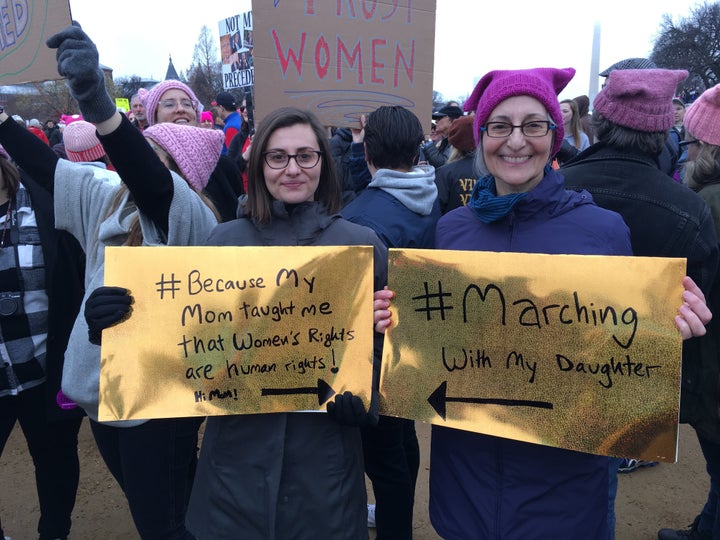
In the late morning of the Women’s March on Washington I felt more like a restless kid on a field trip than a participant in an historic event. I had been anticipating the event for months, but by the time everyone from our group had arrived, we couldn’t get anywhere near the front of the stage. Instead of raising my fist in solidarity while Gloria Steinem proclaimed “Do not try to divide us,” I was munching on trail mix at the back of the National Mall, holding in my pee and wiggling my toes to stay warm.
Like many millennials who protested on Saturday, marching in the streets was something I rarely do. I write about feminism online, but posting my work to social media and watching as the likes, retweets and disdainful comments pour in means I depend on instant feedback to know I’ve made an impact. It’s a well-known stereotype that millennials spend more time engaging with each other online than IRL. We Gchat the colleagues who sit beside us. We text our best friends instead of talking on the phone. Trump’s election was so shocking that it made many of us crave the safety of a real-life community more than our Facebook feeds, myself included. When the Women’s March on Washington was posted to Facebook days after Trump’s election my mom and friends messaged me to say “let’s go.” Without thinking, I said “absolutely.” Though I had no idea what to expect, I knew that I desperately wanted to feel a part of a collective rather than alone and at war on social media. Two months later, standing in a crowd of roughly half a million, I learned that unlike voicing my opinion online, real activism requires us to be participants rather than the centers of attention.
“I learned that unlike voicing my opinion online, real activism requires us to be participants rather than the centers of attention.”
At around 1 p.m., the scheduled march time, protesters in our area began the walk towards the White House. There was a lot of confusion ― I found out later the crowd was so big that even the original route had to be changed ― and I wondered if we were part of the “official” group. I looked at my mother, a former union worker and lifelong feminist who has been to countless protests, and noticed she was more concerned with chanting “We don’t want your tiny hands anywhere near our underpants” than whether or not we were in the right spot. A big group from ASFME was focused on listening to a speech about worker’s rights, not about finding the “real” march. My obsession with personal satisfaction ― I want to be in the center of it all! ― was clearly misguided.
As we walked and chanted, my boyfriend sent me an aerial photo of the Washington rally from MSNBC. My jaw dropped as I realized that every inch of the mall was covered by pink hats. “500,000 or more,” he wrote. The image of the crowd was a visceral reminder that the march’s success didn’t hinge on my instant gratification. It hinged on my physical presence. Women in puffy coats and pussy hats were swarming the National Mall with signs that read “A woman’s place is in the resistance,” and chanting until their voices turned hoarse. It didn’t matter in what direction they were headed. It mattered that they were contributing to a historic headcount.
“The simplicity of showing up and being embraced was something I deeply craved after years of fighting for myself in the online trenches.”
About half an hour later, we merged with a huge group that coalesced near the Washington Monument and started marching together towards the White House. Sandwiched between women (and some dudes) with signs that read “You Can’t Combover Bigotry” and “My Pussy Has Teeth” I felt the protest’s girth. I was finally part of the epic crowd I had imagined. Every 15 minutes or so a loud cheer erupted from the crowd’s belly and spread throughout the masses like an aural stampede. In the two hours it took us to walk less than a mile, I watched a badass woman named Deb confront an anti-Planned Parenthood protester, I screamed “We want a leader, not a creepy Tweeter” at maximum volume and watched a little girl with a sign that said “poopy Trump” lead the protest chant: “Tell me what democracy looks like.”
In those moments I was deeply fulfilled. I was surrounded by community, my voice part of a chorus rather than a lone opinion dangling like bait for egghead avatars to pounce on. I was part of a human shield that for an afternoon, protected hundreds of thousands of women from hate. The simplicity of showing up and being embraced was something I deeply craved after years of fighting for myself in the online trenches.
“In the aftermath of Trump’s election I don’t need to grow my Twitter following. I need to simply show up.”
When we finally made it to the park outside the White House, I stood on muddy ground that smelled like a barn and tried not to think about my wet socks. The crowd was invading the area to the sound of a marching band. My friends and I were ready to leave but my mom ― a veteran protester ― suggested we stay for a bit longer to “help take up space.” She knew footage of the maximum number of marchers swarming the area that borders Trump’s new back lawn was more important than our sinking energy levels. Our physical presence mattered more than our personal comfort.
Later on that night, we turned on TV and saw that protesters turned out in historic numbers to fill cities across the world with pink dots. We heard the anchor say the D.C. event was the largest inaugural protest ever and the start of “an era of unprecedented political activism.” The next morning, we kept talking about the march. On Monday she texted me from the airport that “The struggle continues.”
Indeed, the biggest question is what to do now that women have taken off their pussy hats. I helped make history, but like most millennials, I’ll likely return to spending 10 hours a day online, fishing for self-esteem via Facebook likes. Though getting involved in midterm elections, writing to senators and volunteering for social justice organizations don’t make pretty Instagram posts, I know those actions are crucial. In the aftermath of Trump’s election I don’t need to grow my Twitter following. I need to simply show up.
